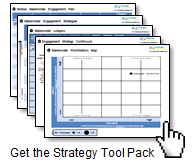
Stakeholder resistance, if it gains a foothold on a large scale, can threaten to derail even the most positive change effort. There are four primary reasons1 that people resist change. Once you know what types to look for, you will be better equipped to spot change resistance in your organization.

After you have identified the types of change resistance present in your organization, employ a mix of strategies to counter the negative forces. Following are six classic strategies1 for dealing with change resistance (in order from least to most extreme) – use them to develop action plans that address the resistance within your organization.
- Education & Communication: One of the best ways to overcome resistance to change is to educate people about the change effort beforehand. Up-front communication and education helps employees see the logic in the change effort. This reduces unfounded and incorrect rumors concerning the effects of change in the organization.
- Participation & Involvement: When employees are involved in the change effort they are more likely to buy into change rather than resist it. This approach is likely to lower resistance more so than merely hoping people will acquiesce to change.
- Facilitation & Support: Managers can head-off potential resistance by being supportive of employees during difficult times. Managerial support helps employees deal with fear and anxiety during a transition period. This approach is concerned with provision of special training, counseling, time off work.
- Negotiation and Agreement: Managers can combat resistance by offering incentives to employees not to resist change. This can be done by allowing change resistors to veto elements of change that are threatening, or change resistors can be offered incentives to go elsewhere in the company in order to avoid having to experience the change effort. This approach will be appropriate where those resisting change are in a position of power.
- Manipulation and Cooptation: “Cooptation” (no it’s not misspelled) involves the patronizing gesture of bringing a person into a change management planning group for the sake of appearances rather than their substantive contribution. This often involves selecting leaders of the resisters to participate in the change effort. These leaders can be given a symbolic role in decision making without threatening the change effort.
- Explicit and Implicit Coercion: Managers can explicitly or implicitly force employees into accepting change by making clear that resisting change can lead to losing jobs, firing, or not promoting employees.
 >> Download the Stakeholder Engagement Strategy Tool Pack to help you analyze and prioritize your initiative’s stakeholders, identify appropriate stakeholder engagement methods, and develop a tactical stakeholder engagement plan.
>> Download the Stakeholder Engagement Strategy Tool Pack to help you analyze and prioritize your initiative’s stakeholders, identify appropriate stakeholder engagement methods, and develop a tactical stakeholder engagement plan.
Also, be sure to check out Nine Strategies for Overcoming Change Resistance and How to Prioritize Stakeholders to Ensure a Successful Change Program.
1Adapted from Kotter & Schlesinger Choosing Strategies for Change (1989)












4 comments
Pingback: Defenders of the Status Quo «
Pingback: Challenges to Merging Organizations «
Pingback: How New (and Experienced) Managers Can Support the Change Process « Emergent Insights
Pingback: » Methods for Overcoming Change Resistance